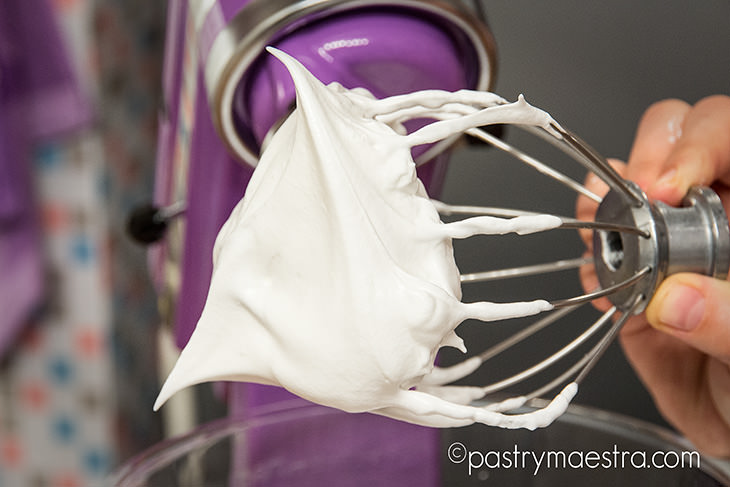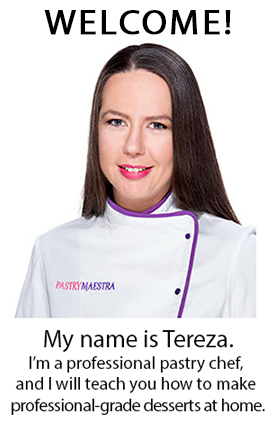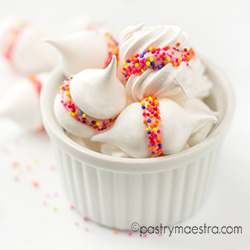
W
ould you care for some crispy, sweet meringue kisses, possibly filled with dark chocolate ganache? Or, maybe, you’ve just felt a sudden craving for a bite of light, melt-in-your-mouth Pavlova – a meringue and crème Chantilly goodness, topped with fresh, seasonal fruits and drizzled with passion fruit coulis? Do you absolutely LOVE that fluffy, white caramelized layer of lemon meringue tart? You too? Want to learn how to make all that? You are just in the right place!
What is Meringue?
Meringue is a mixture made by whipping egg whites with some sugar. The easiest way is to whisk it in your stand mixer. If you don’t have one, you can also use a hand mixer. And if you want to burn all that meringue calories in advance, you can whip it by hand, using your elbow grease and a good old whisk.
Meringue can be soft or firm, depending on the ratio of egg whites and sugar. The less sugar meringue contains, it will be softer, no matter how long or hard you beat it. However, if meringue contains much more sugar than egg whites, it will be firmer and more stable.
The History of Meringue
The origin of meringue is quite mysterious. The idea of whipping egg whites with some sugar could have originated in any European country, so there is no wonder that the Swiss and the Italian claim this airy, sweet invention. According to famous French pastry chef Pierre Hermé, food historians believe that one of two legends could be the right one. The first story leads to family Visconti-Forza, the dukes of Milan, Italy, and the other legend mentions family from Abruzzo, Italy. Allegedly the mother mixed some hop, watermelon seeds and fine sugar, and her daughter got the idea to incorporate cooked sugar into the whipped egg whites. It is believed that this concoction was the predecessor of Italian meringue.

But, wait, there are other stories about meringue! Another story claims that meringue was invented in Swiss village of Meiringen (today it is situated in Germany) and improved by an Italian chef named Gasparini at the turn of 17th and 18th century. There is one more legend that says that the word “meringue” comes from the Polish word “marzynka” and that the preparation was invented by a chef in the service of King Stanislas I Leszczyński, who later became Duke of Lorraine. Who knows how many more stories and legends about meringue origin are undiscovered, somewhere out there.. However, the Oxford English Dictionary states that the French word “meringue” is of unknown origin! What is certain is that the name meringue for this confection first appeared in print in François Massialot’s cookbook published in 1692 France. One more fact – meringues were traditionally shaped between two large spoons, and the first one who used the piping bag for shaping meringues was famous French chef Antoine Carême.
What Sugar to Use?
For starters, if you’ve never used anything other than white sugar, and you would like to know more about alternatives, go and check my post about sugar and other sweeteners. Or you can do that later, but for now, you don’t need other sweeteners because to make any meringue successfully, all you will need is superfine white granulated sugar. Why superfine? It is easy – smaller crystals dissolve more quickly. And crystals have to dissolve. You could use plain granulated sugar with larger sugar crystals, but you will have to whisk the meringue for a longer period for the crystals to dissolve. By doing that, you risk overbeating your egg whites. And trust me, you don’t want to do that. So try your best to browse through your supermarket shelves and find caster sugar or superfine granulated sugar. Your meringue kisses will be grateful.
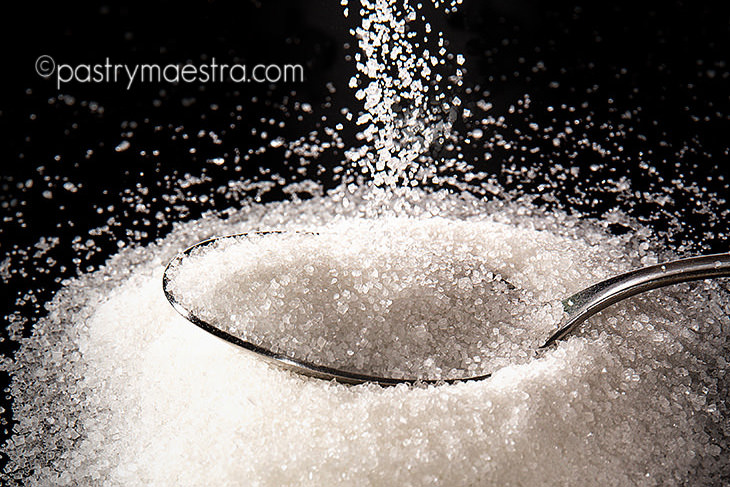
3 Types of Meringue
There are three methods of making meringue: French, Swiss and Italian.
French Meringue
To make French or common meringue, you first have to whisk your egg whites until they form soft peaks. Then, you start adding granulated sugar gradually while whisking continuously until the meringue is done.
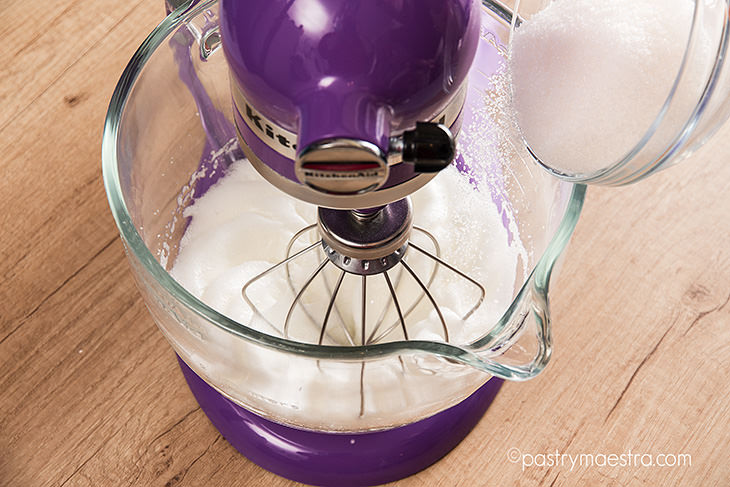
‘How do I know it’s done?’ – you probably ask yourselves. As I’ve already said, if you are making a recipe where you have less sugar than egg whites, your finished meringue is going to be soft, but shiny and smooth, without visible sugar crystals. You can check it by rubbing a small amount between your fingers – if you can’t feel sugar crystals, it is done.
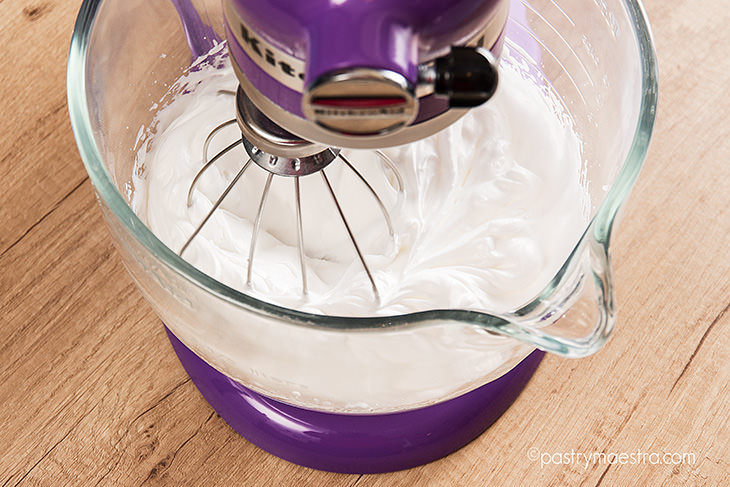
This sort of meringue is usually folded into sponge cakes before baking, and it is important to use it as soon as you make it. Otherwise, it will deflate. If you are making meringue with the double amount of sugar then egg whites by weight, when done, your meringue will be stiff, shiny, and also without sugar crystals. This stiff meringue is usually piped into rosettes or disks, and then baked at low temperature until dried. And voilà – your meringue kisses from the beginning are done and ready to be nibbled!
Swiss Meringue
Swiss meringue is the only method where you combine egg whites and sugar in a bowl immediately, before whisking. Put the bowl on a bain-marie, which is a French term for double boiler (a pan filled with simmering water). Simmering water heats the mixture gradually and whisking it while heating, helps to keep the temperature inside of the bowl uniform.
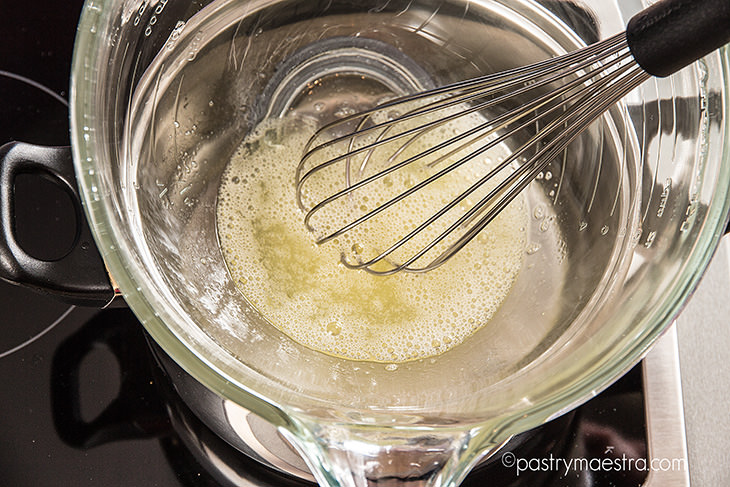
At this stage, you want to take out your candy thermometer. I like to use my digital thermometer with a probe because it gives fast and accurate reading. If you don’t have a thermometer, I would recommend buying one. You should whisk your egg whites with sugar on a bain-marie until the mixture reaches 70°C (158°F), and at that point, all the sugar crystals should be dissolved.
Interestingly enough, different sources declare different temperatures for making Swiss meringue. Some say 40°C (104°F) is just fine, others claim 60°C (140°F) is the right temperature, while I prefer 70°C (158°F). I will tell you why. Egg white is a potentially hazardous ingredient, as you all know, because of Salmonella, bacteria that causes Salmonellosis – severe food borne illness. If we heat egg whites to 70°C (158°F), that will kill Salmonella and that is the main reason I prefer that temperature. The other one is – if you need to put a large amount of sugar in your Swiss meringue, it won’t dissolve at lower temperatures.
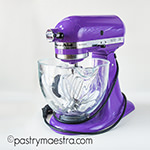
So, you have heated your mixture up to 70°C (158°F), but you still have work to do! Now the real whisking begins. That is why I like to prepare Swiss meringue in the bowl of my stand mixer. When I am done with bain-marie, I just attach the bowl and its whisk to the mixer, and electricity does the rest. Swiss meringue is very stable. You can use it as a base for buttercream, you can top a tart with Swiss meringue, or you could pipe it and dry it out like we do with French meringue.
Italian Meringue
Italian meringue is made by cooking sugar syrup to soft ball (116°C-118°C/240°F-244°F) or firm ball (118°C-121°C/245°F-250°F) stage, and pouring it into foamed egg whites. All about cooking sugar syrup you can learn in my post.
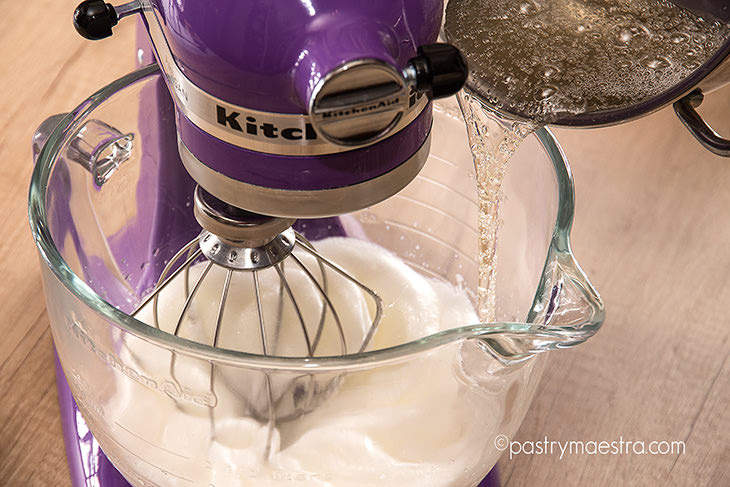
Continue to beat the meringue until it cools down slightly. Italian meringue should be used warm, immediately when it is done.

It is important to whip the whites to a right consistency before pouring the syrup – if you don’t beat them enough, meringue won’t rise as it should. If you overbeat the whites, the meringue will become grainy. The heat will stabilize the egg whites and make them safe to eat. Italian meringue is usually used to top a dessert, or it can be folded into mousse or Semifreddo. It is not suitable for drying in an oven like French and Swiss meringue are.
Chemistry Behind Meringue
The interesting fact is that egg whites are approximately 90% water. The other 10% are protein. But, it isn’t that simple. Inside that 10%, there are 40 different types of protein! Some of them attract water, and some of them are repelled by water. Some coagulate at 63°C (145°F), and the others at 70°C (158°F). When you start whisking the egg whites and inserting air, the water-attracted proteins stick to the water, and water-repelling proteins stick with the air. When you start adding sugar, it acts like glue, which sticks two opponents together and stabilizes meringue.
7 Most Important Meringue Tips & Tricks
- When making meringue, always have your egg whites at room temperature, they will whip easier and get more volume.
- Be careful not to incorporate any particles of egg yolks into your egg whites. The fat from the yolk will prevent egg whites to whip.
- Don’t use plastic bowls for making meringue, as they tend to retain grease.
- When making Swiss meringue, be careful to cook it to the exact temperature, if you overheat the egg whites, you will end up with sweet scrambled egg whites – doesn’t sound tempting to eat.
- When you are baking meringue, make sure to dry it at 80°C-100°C (176°F-212°F), and open the oven doors frequently so the moisture can escape. That will prevent meringue from cracking.
- An acid, such as cream of tartar or lemon juice helps stabilizing meringue – use 10g (2Tsp) of acid per 500g (1.1lbs) of egg whites.
- Keep your baked meringue in an airtight container as they soak the moisture from the air and become soggy.
How to Prevent Meringue from Weeping?
Meringue weeping may occur when you put it on top of a tart or a pie, for example when you make lemon meringue tart or any other meringue topped dessert.
- If you are using French meringue, make sure all the sugar crystals are dissolved, and be careful not to overbake your meringue!
- Try to cover the entire surface of the tart/pie filling, all the way to the crust. That way you will seal the filling and prevent weeping.
- Use cooked meringue – Swiss or Italian! That way, you don’t need to put everything back in the oven, just burn the surface of your meringue with a blowtorch. Choose your meringue wisely!
- If your meringue isn’t properly cooked, that could cause weeping.
- Make sure to spread your meringue on top of the filling as soon as it is done. If you let your meringue to sit on a counter for a long time, that will change it’s texture.
Now, it is your turn! It is time to roll up your sleeves and whip up some of the delicious treats made out of this sweet, airy delight! Bon appétit!
